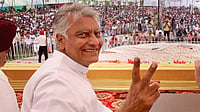The Bharatiya Janata Party (BJP)-led Narendra Modi government's decision to cut deadwood from bureaucracy has invited sharp criticism from employees' unions and former civil servants. The government has recently revived a premature retirement plans for central government employees who have completed 30 years in service or reach 50 years of age after reviewing their performance on a regular basis.
An order issued by Department of Personnel and Training (DoPT) on June 20 notifies that all central government establishments must send detailed monthly reports of how many central government employees were reviewed and how many were recommended for premature retirement. Those who are disqualified will be given three-month notice to retire from service.
However, this is not the first time the Modi government is introducing such a measure. In 2014, too, the government moved an order to give premature retirement to central government officials.
Speaking on the condition of anonymity, a former civil servant said the Centre's move was an attempt to privatize government sector.
He also pointed out that since the government has revived the 2014 order after slight modification, it shows its commitment to implement it.
In a bid to rid the bureaucracy of “unproductive officers”, the Centre has now decided to review the performance of bureaucrats on a regular basis.
But this time, the order has been modified and issued to all ministries and departments—including the Prime Minister's Office, President's Secretariat and Cabinet Secretariat.
The order comes at a time when there is a widespread concern in the bureaucratic circle over Modi government’s forced retirement of top 27 tax officials on the grounds of corruption and misconduct. An official, familiar with the development, says the government’s decision to induct 400 private sector specialists at middle-level through lateral entry is indicative of a shake-up in the public administration service.
The DoPT order also says, "The Ministries should ensure that the prescribed procedure like forming of opinion to retire a government employee prematurely in public interest is strictly adhered to, and that the decision is not an arbitrary one, and is not based on collateral grounds as per the order of the Hon'ble Supreme Court in case of lJOt & Col. J.N.Sinha [1571 SCR (1) 791]”.
The latest DoPT order states that the review process must be in accordance with the orders in 2014, 2015, and 2017. Detailed guidelines for performance review have been given in the previous order, citing various Supreme Court observations. The new order applies to employees in the A, B, and C groups, whereas the first order applies only to A and B group level officers.
D Manoharan, General Secretary of Southern Railway Employees Union, points out that three lakh railways employees will be affected if the government implements the order. “The government has issued the order for the second time. They are serious about implementing it. In our view, the government wants to reduce the workforce of the central government slowly and wants to privatize the central government sectors,” said Manoharan.
He added that employees union will intensify their agitation if the government begins the process of sacking employees.


























